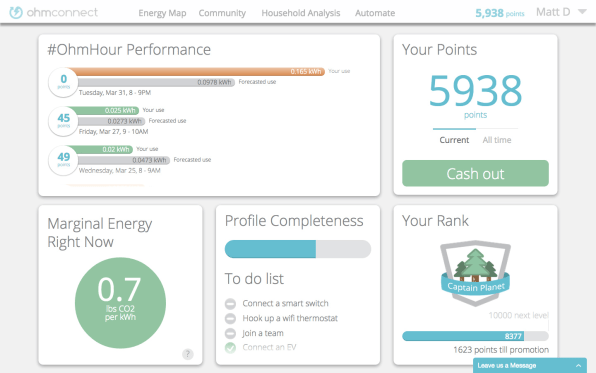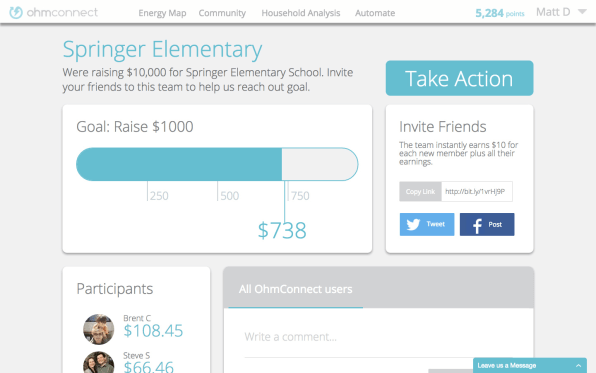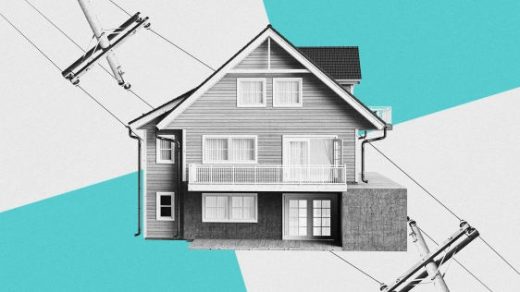This Startup Will Pay You To Use Less Electricity
When a single homeowner decides to turn off her TV in the evening, the action barely registers on the electric grid. It’s one appliance in one home, out of millions. But when thousands of homeowners turn off their TVs, dim their lights, and do without their washing machines for an hour, well, then the collective impact can make a difference. Potentially it’s the difference between a grid that’s well managed and a grid that’s forced into using emergency power that’s expensive and polluting.
Since it was founded four years ago, OhmConnect has shown how aggregating the energy-saving actions of thousands of homes can add up to something worthwhile. The San Francisco startup has managed to sign up 290,000 customers for its hour-long “demand response” events, gathering small shifts in behavior into something larger and more meaningful. These days, several Californian utilities pay for its services, preferring what are called “negawatts” (units of power saved) to using their plants to generate actual kilowatts and megawatts of electricity.

“A lot of people use us as an excuse to unplug and play a board game with the family,” says Curtis Tongue, cofounder of the startup, giving an extra reason why people like to participate with Ohmconnect’s programs. But freedom from evening electronic stimulation probably isn’t the main driver. Instead, it’s probably the hard cash they get for doing it. In return for reducing their power consumption, its customers are rewarded with points that can be redeemed for dollars. Tongue says a small apartment participating once a week can make $40-$50 a year. A larger home with several power-hungry appliances can save up to $200 a year. “It’s nice pocket change,” he says.
Utilities have long asked their customers to help them balance supply and demand on their networks. But traditionally “demand response” (the technical term) has involved very large consumers. An aluminum smelter owner for instance might agree to shut down on a summer’s day to offset demand from people’s air conditioners. Tongue says the industry was initially skeptical about a consumer-facing demand management business. But gradually they’ve come around: Pacific Gas and Electric, Southern California Edison and San Diego Gas & Electric are all OhmConnect customers now.
OhmConnect monitors energy markets for spikes in power demand. When it sees that the grid is in need of some demand reduction, it sends out text messages to its user-base suggesting energy-saving actions–like doing without the washing machine for an hour. When users sign up for the service, they agree for OhmConnect to monitor their home’s smart meter to understand their historical power usage. The startup compares a home’s energy usage in a given “OhmHour” against the previous 10 weekdays or four weekend days. For instance, if a home is asked to save energy on a Wednesday, the baseline might be an average of their usage at the same time on the previous Tuesday, Monday, Friday, and Thursday.
Tongue says an increasing proportion of customers–up to 19% currently– choose to automate how they respond to requests. For example, they open access to their Nest thermostat to turn down the temperature slightly at the given hour, or they set their home Tesla charging station not to power up during the allotted period.
Persuading so many users to sign up and participate hasn’t been easy, says Tongue. But OhmConnect has gradually become more canny about how it nudges customers into co-operating. For one thing, it operates on a fully opt-out basis. Shortly before an OhmHour, customers receive a message asking whether they want to participate. In other words, you have to make a choice to say you won’t play ball, upping the likelihood that you will.
OhmConnect also plays on a powerful observation from the field of behavioral economics called “loss aversion.” That says that people are more likely to want to avoid losses than make gains. Messages before OhmHours are somewhat guilt-inducing, making it clear that a community of energy-savers is depending on you, the user, to do your bit. Similarly, when people forget to take part, or they opt-out, a message will make it clear that they’ve let down fellow users. Other techniques include deducting points from non-participants and increasing them for people who participate regularly and dependably.

Now that it’s established in California, OhmConnect sees opportunities to grow in other places, including Texas and Toronto, and possibly on the East Coast. The startup makes money by taking a 20% cut on the amounts utilities offer for energy savings. (Tongue won’t give actual dollar numbers or indicate whether the business is profitable yet.) The contract with San Diego Gas & Electric is for 4.5 megawatts of power flexibility on any 20-minute period. In four years, OhmConnect has saved California’s grid 100 megawatts in all, or the equivalent of two peaker plants that no longer need to be fired up in high-demand moments.
In a report last year, Grand View Research said the demand response market will be worth $35.9 billion by 2025, with the residential sector accounting for about a quarter of that. So there appears plenty of revenue for startups like OhmConnect to go after if it can continue persuading households to participate.
“Consumer awareness is a significant headwind,” Tongue says. “Most people are not aware in California that a company like OhmConnect actually pays out for saving energy. But we do see a lot of the market shifting to an energy sharing model instead of demand response on the commercial side.”
Fast Company , Read Full Story
(24)














